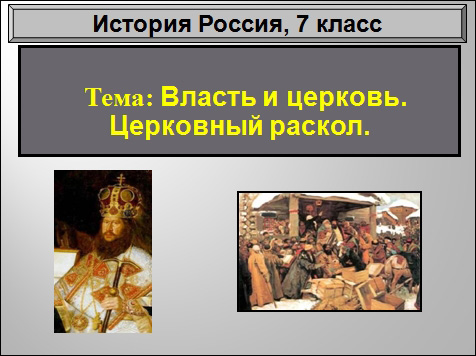history-master
It is the sanctuary of God’s people.
Objective of the lesson:To form an idea of the role of the Orthodox Church in the life of the Russian state in the XVII century.
- to highlight the problems in relations between the state and the church;
- to find out the causes and consequences 6 of the church schism;
Equipment:computer, presentation, multimedia screen, cards to check homework.
Basic concepts:Church, Patriarch, Old Believers, Schism, Protopope.
Class progress
1. Org. lesson start.
2. Checking homework.
Fill in the blanks.
Option 1.
1. The first Russian king of the new dynasty was ______________________________________________________________________________________________________________________________________________________________________________________________________________________________________________________
2. The decision of the young king was greatly influenced by his mother ___________________________________________________________________________________________________________________________________________________________________________________________________________________________________________________
3. The new king loved ___________________________________________________________________________________________________________________________________________________________________________________________________________________________________________________________
4 The new king is called _________________________________________________________________________________________________________________________________________________________________________________________________________________________________________________________
5. That second marriage with Natalia Naryshkina, the young tsar had a son ______________________________________________
6. Gradually, _______________________________________ is beginning to lose its role.
7. The increase in the number of __________
8. At the head of the main administrative units, the king put ___________________.
Option 2.
1. By the beginning of the reign of Mikhail Fedorovich, he was _________ years old.
2. Ascending to the throne, the new king promised not to rule without the boyars and ___________________________________________________________________________________________________________________________________________________________________________________________________________________________________________
3. After the death of Mikhail Romanov, his son became his new king.
4. From his first marriage to Maria Miloslavskaya, Alexei had 13 children, including sons __________________________________________________________________________________________________________________________________________________________________________________________________________________________________________
5. The last council was convened in ___________.
6. Subsequently, the Boyar Duma was allocated "_________________________"
7. in the seventeenth century, the main administrative units were _______________________, which were divided into smaller units ____________ and _________________.
8. In 1649, a new set of laws was created called ___________________________________________________________________________________________________________________________________________________________________________________________________________________________________________________
Keys:
| Option 1 | Option 2 | ||
| 1 | Mikhail Fedorovich Romanov | 1 | 116 |
| 2 | marta | 2 | Zemstvo Cathedral |
| 3 | Flowers. | 3 | Alexei |
| 4 | Quietest. | 4 | Fedor and Ivan, Sofia |
| 5 | Peter | 5 | 1653. |
| 6 | boyar | 6 | Nearby |
| 7 | Orders. | 7 | County, country and volost |
| 8 | governor | 8 | By conciliar arrangement |
3. Communication of the topic and objectives of the lesson.
- In the history of our country there are many periods that are very instructive. One of those times was the time of division. The word “split” for many centuries has preserved horror in the hearts of people and left its mark on the fate of many families. Our task today is to deal with this phenomenon in the life of the country, to draw lessons from what happened in order to prevent a repetition of these terrible events. In the course of the lesson, we will fill out a table: “Major changes in church rites and services.” Was church reform justified in the eyes of the people? Was it necessary for the country or individuals?
Lesson plan: (page 2)
1.The Church after the Troubles.
2.Patriarch Filaret.
3.Reform of Patriarch Nikon.
4. Increased differences between church and secular authorities.
5. Church Council 1666-1667.
6. Protopope Avvakum.
4. Studying new material.
(1) the teacher's conversation and story:
1. The church after the Troubles.
- What role does the church play in human life?
- What was the situation of the church during the Troubles?
- What path did the clergy choose during the reign of False Dmitry? (Part of the clergy headed by Patriarch Ignatius supported False Dmitry 1, and the patriarch himself crowned him to the kingdom.) However, most clergymen showed examples of high service to the Fatherland and the Russian Orthodox Church.
- How did the Poles behave in Moscow?
- Troubles became a severe test for the Church. The Poles who were in Moscow during the Troubles not only plundered church utensils and desecrated the relics of the saints, but also destroyed almost all 450 Moscow churches during the retreat. The mass phenomenon was the murder of church officials, taking them hostage. Among the prisoners was the actual head of the Russian Orthodox Church, Metropolitan Filaret. But all this did not break, but on the contrary strengthened the spiritual strength of believers in clergy.
2. Patriarch Filaret.
(Section 3)After 8 years in Polish captivity, Tsar Michael’s father Metropolitan Filaret returned to Moscow in 1619. The participants of the Church Council elected him the new Patriarch of Moscow and All Russia. Under him, the role and importance of the church in the life of the state increased significantly.
- Why? He was, in fact, the second tsar: all reports on state affairs were heard by the tsar and the patriarch together, and Michael never made decisions without the consent of his father. It also happened that one patriarch gave orders on purely state issues.
- The main thing that Filaret managed to achieve was to strengthen the authority and power of Tsar Mikhail Fedorovich. However, many church issues were never resolved. Among them, the main issue was the renewal of church books and ceremonies.
3. The reform of Patriarch Nikon.
(Section 4)In the middle of the 17th century it became clear that in Russian church books, hand-written from century to century, there are many errors and distortions of the text in comparison with the original. Many doubts were caused by the customs of polyphony during the church service, when everyone prayed using different prayers, baptism with their fingers.
(Section 5).On this issue, the views of believers are divided.
1) Some proposed to correct church books and rites, returning to the ancient Russian rites.
2) Others believed that one should turn not to the books of a century ago, but to the Greek sources from which they were copied.
(Section 6).The new head of the Russian Orthodox Church was electedNikonMetropolitan of Novgorod. He was charged with carrying out church reform.
(2) textbook work:
- Let's get acquainted with the biography of Patriarch Nikon. pp. 57-58.
(Section 7)
In 1653-1655, church reform began. It was introduced:
- Baptism with three fingers;
- They are the ones who worship the earth.
- Icons and church books were corrected according to Greek samples.
- How do you think the population perceived these innovations?
- These changes have causedprotestthe general population. In addition, the war with the Polish-Lithuanian Commonwealth that began, the victims and losses associated with it were regarded by ordinary people as God’s punishment for violating church traditions. Convened in 1654, the Church Council approved the reform, but proposed to bring the existing rites in accordance not only with the Greek, but also with the Russian tradition.
4. Increased differences between church and secular authorities.
(Section 8)
The new patriarch was a wayward, strong-willed and even fanatical man. Having gained immense power over the faithful, he soon came up with the idea of the primacy of ecclesiastical power over the tsarist one and offered Alexei Mikhailovich to share power with him, following the example of Tsar Mikhail Fedorovich and Patriarch Filaret.
- How do you think Mikhail Fedorovich reacted to such a proposal?
- These statements and moralizing of the Patriarch the Tsar did not want to endure for a long time. He stopped attending patriarchal services in the Assumption Cathedral, inviting Nikon to state receptions. This was a serious blow to the ego of the patriarch. During one of the sermons in the Assumption Cathedral, he announced the abdication of patriarchal duties and retired to the Resurrection Monastery. There Nikon began to wait for the tsar to repent and ask him to return to Moscow. However, Alexei Mikhailovich acted quite differently. He began to prepare the church trial of Nikon, for which he invited Orthodox patriarchs from other countries to Moscow.
(4) textbook work:
Page. 59 – “Church Council”
- Let's read about how the Church Trial of Nikon took place.
(5) the teacher's account:
6. Protopope Avvakum.
An outstanding leader of the Old Believers was Protopop Avvakum.
- Let's write down the definition:
(Section 9)
ProtopopeThe common name of the senior Orthodox priest.
(page 10)From a young age, devoting himself to the church, he was an active supporter and righteous person of a pious lifestyle. Nikon's reforms he took sharply negatively. For his views, he was deprived of a place in the Moscow Kazan Cathedral, and then arrested and imprisoned in a monastery. Later, Avvakum was exiled with his family to Siberia.
(Section 11)
Wherever his fate threw, Avvakum led an active propaganda of Old-believers' ideas and principles. In 1664 he returned to Moscow, where the tsar and other acquaintances vainly urged him to accept church reform. For his refusal at the Church Council of 1666-1667, Habakkum was subjected to church curse and cut off from the priests, and then again imprisoned. For his disobedience and intransigence, Avvakum was sentenced by the Church Council of 1681-1682 to execution. On April 11, 1862, the “furious protopope” and his associates were burned alive.
Thus, the Church, which strengthened its position after the Troubles, tried to take a dominant position in the political system of the country. However, with the strengthening of the autocracy, this led to a conflict between the authorities and the church. The defeat of the church in this clash prepared the ground for its transformation into an appendage of state power.
5. Summary of the lesson
Questions on page. 60.
6. Homework:
Paragraph 7, questions, notes, repeat terms, workbook.


{module Google_kvadrat}
The presentation contains 14 slides. Download the lesson summary and presentation, with a volume of 527 KB, you can completely free.


